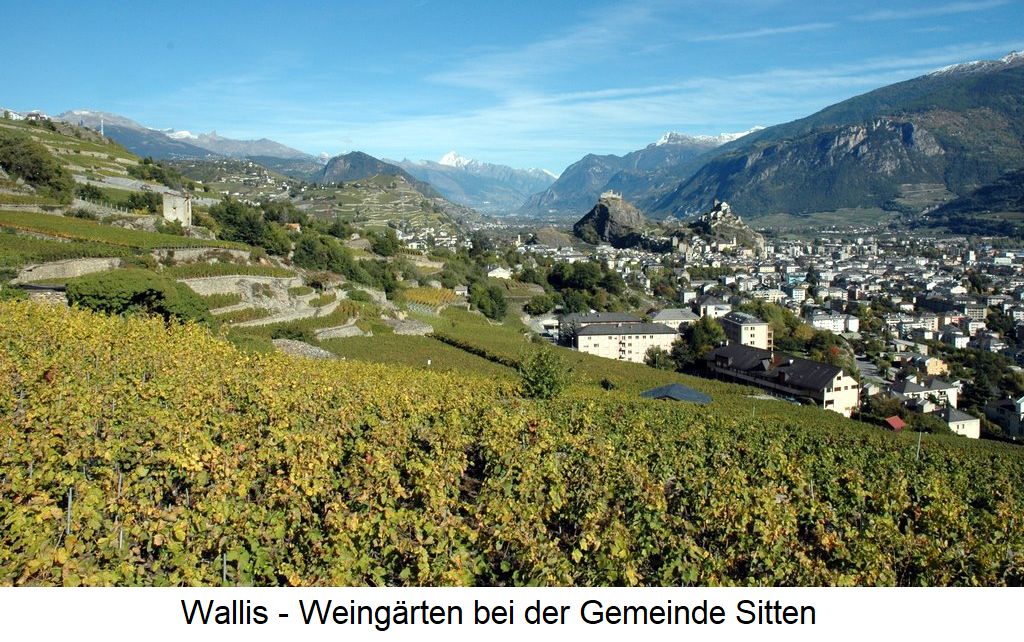Results
2,285 Results
Loading more Results ...
Loading more Results ...
Wine regions in Wallis/Valais 1 growing regions
Description to Wallis/Valais
Switzerland 's third largest canton, with Sion as its capital. In 2007, scientists from the University of Basel discovered that vines were already cultivated here between 800 and 600 BC. Today, the vineyards stretch for over 50 kilometres from the German-speaking Upper Valais to the French-speaking Lower Valais along the Rhône at an altitude of 450 to 650 metres above sea level. Those of Visperterminen in the Upper Valais are even considerably higher at 1,100 metres. The Riebe vineyard there is the highest vineyard in Central Europe. The majority of the vineyards are located on the right bank of the Rhône, facing south from Martigny to Leuk. Smaller areas are located between Lake Geneva and the Rhône bend near Martigny. The vineyards on steep slopes, bordered by high walls, are mostly terraced, some of them as so-called "tablars" cut horizontally into the slope. Due to the extreme slope, some areas are among the steepest vineyards in Europe. Limestone, gneiss, slate and alluvial soils predominate.

Grape varieties
Valais is one of the six Swiss wine regions. The vineyards cover 5,236 hectares. They are characterised by around 60 different, mostly autochthonous grape varieties, only four of which account for almost 90% of the area. These are, with over half, Fendant(Chasselas), Pinot Noir, Gamay and Silvaner. With the neighbouring Italian Aosta Valley, a geographical island is formed with a variety of very old, autochthonous grape varieties known as Alte Gewächse. Traditional for Switzerland, some of the white wines still undergo malolactic fermentation. Pinot Noir and Gamay are used to produce the traditional red wine Dôle. A rarity are the so-called 36 Plants, which are wines made from (formerly actually 36) different grape varieties. Sweet late harvests (Flétri) with a potential alcohol content of up to 20% vol. are a speciality. Above Sierre, the glacier wine (Vin des Glaciers) comes from the Val d'Anniviers (Eifisch Valley).
Smallest vineyard in the world
The smallest vineyard in the world is located in the municipality of Saillon. On the "vineyard", which is only 1.618 square metres in size and registered in the land register, there are only three vines of the Red Muscat variety (mutation of the Muscat). From the yield, a wine is pressed in a special way (see Vineyard of the Dalai Lama).
Appellation system
In 1993, Valais was the first canton to introduce the AOC appellation system. Individual vineyards are classified as Grand Cru by municipal regulations, with even stricter requirements than for AOC. Grand Cru vineyards must have AOC status. There are the following AOC communes: Ardon, Ayent, Chamoson, Conthey, Fully (Grand Cru sites), Grimisuat, Lens, Miège, Saillon, Salquenen (Salgesch) Savièse, Saxon, Sierre, Sion, St-Léonard (Grand Cru sites), Varen, Venthône and Vétroz (Grand Cru sites). Around 22,000 winegrowers, some of them with very small holdings with only a few hectares of vineyards, produce around 40% of Swiss wine. 60% of these are white wines and 40% red wines.
Producers
Well-known wine producers or trading houses are Bonvin, Domaine du Mont d'Or, Favre, Gay, Germanier, Gilliard, Imesch, Johanniterkellerei, Mathier Albert, Nouveau Salquenen, Orsat, Provins Valais, Rouvinez, Varone and Vins des Chevaliers.
Image: By Vheritier, CC BY-SA 3.0, Link
Classified wine producers in Wallis/Valais 3
find+buy for Wallis/Valais 14
Recent wines 39
 Les Fils de Ch. Favre
— Wallis/Valais
2021 AOC Valais Pinot Noir "Hurlevent"
14.90 €
Les Fils de Ch. Favre
— Wallis/Valais
2021 AOC Valais Pinot Noir "Hurlevent"
14.90 €

 Les Fils de Ch. Favre
— Wallis/Valais
2020 AOC Valais Pinot Noir "Collection F"
26.50 €
Les Fils de Ch. Favre
— Wallis/Valais
2020 AOC Valais Pinot Noir "Collection F"
26.50 €

 Rouvinez Vins
— Wallis/Valais
2020 AOC Valais Pinot Noir "Colline de Géronde"
26.00 €
Rouvinez Vins
— Wallis/Valais
2020 AOC Valais Pinot Noir "Colline de Géronde"
26.00 €

 Cave St-Pierre
— Wallis/Valais
2020 AOC Valais "Dôle"
9.95 €
Cave St-Pierre
— Wallis/Valais
2020 AOC Valais "Dôle"
9.95 €

The most important grape varieties
More information in the magazine
- Cave Biber, Salgesch Cornalin 2011, Valais, Switzerland
- Cave Beaver Syrah 2011, Salgesch, Valais, Switzerland
- Château de Muzot Réserve 2011, Cuvée Rouge, Valais AOC, Switzerland
- Three vines and lots of celebrities The smallest vineyard in the world
- The unequal brothers In FocusSpätburgunder from German-speaking wine-growing regions
- "Only those who seek will find!" Interview with grapevine breeder Valentin Blattner about his search for ever more resistant varieties
- Business as usual - with all the obstacles Wine trade between EU and Switzerland remains complicated after failed trade agreement
- "Drinking is not more, but more expensive". Interview with Marc Almert, head sommelier at Zurich's Hotel Baur au Lac, about the new start after the Corona lockdown.
- Winegrowers' cooperative Wartenfels Castle Wartenfelser 2013, Johanniter and Seyval Blanc, Solothurn, Switzerland
- Gian Battista von Tscharner Schiller 2006, Wingert Orphanage, Chur, Switzerland